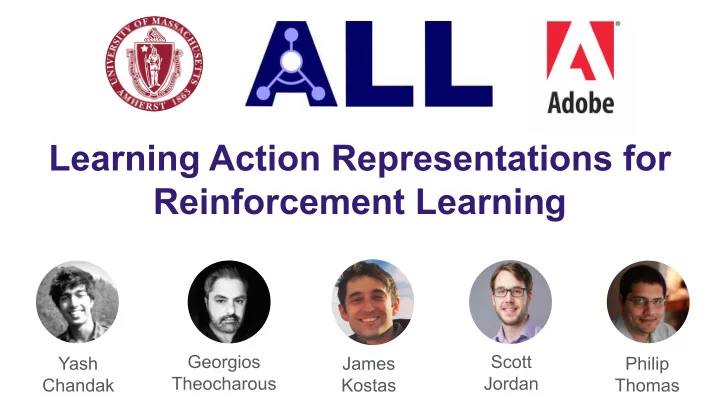

Learning Action Representations for Reinforcement Learning Georgios Scott Yash James Philip Theocharous Jordan Chandak Kostas Thomas
Reinforcement Learning
Problem Statement Thousands of possible actions!
Problem Statement Thousands of possible actions! ● Personalized tutoring systems
Problem Statement Thousands of possible actions! ● Personalized tutoring systems ● Advertisement/marketing
Problem Statement Thousands of possible actions! ● Personalized tutoring systems ● Advertisement/marketing ● Medical treatment - drug prescription
Problem Statement Thousands of possible actions! ● Personalized tutoring systems ● Advertisement/marketing ● Medical treatment - drug prescription ● Portfolio management
Problem Statement Thousands of possible actions! ● Personalized tutoring systems ● Advertisement/marketing ● Medical treatment - drug prescription ● Portfolio management ● Video/Songs recommendation
Problem Statement Thousands of possible actions! ● Personalized tutoring systems ● Advertisement/marketing ● Medical treatment - drug prescription ● Portfolio management ● Video/Songs recommendation ● … ● … ● Option selection
Problem Statement Thousands of possible actions! ● Personalized tutoring systems ● Advertisement/marketing ● Medical treatment - drug prescription ● Portfolio management ● Video/Songs recommendation ● … ● … ● Option selection
Key Insights - Actions are not independent discrete quantities.
Key Insights - Actions are not independent discrete quantities. - There is a low dimensional structure underlying their behavior pattern.
Key Insights - Actions are not independent discrete quantities. - There is a low dimensional structure underlying their behavior pattern. - This structure can be learned independent of the reward .
Key Insights - Actions are not independent discrete quantities. - There is a low dimensional structure underlying their behavior pattern. - This structure can be learned independent of the reward . - Instead of raw actions, agent can act in this space of behavior and feedback can be generalized to similar actions.
Proposed Method
Algorithm (a) Supervised learning of action representations.
Algorithm (a) Supervised learning of action representations. (b) Learning internal policy with policy gradients.
Results
Results
Results
Results
Real-world Applications at Adobe Photoshop HelpX Actions = 1498 tutorials Actions = 1843 tools
Poster #112 Today
Results (Action representations) Actual behavior of 2 12 Maze Learned representations of 2 12 actions domain actions
Policy decomposition
Case 1: Action representations are known - The internal policy acts in the space of action representations - Any existing policy gradient algorithm can be used to improve its local performance, independent of the mapping function.
Case 2: Learning action representations - P(a|e) required to map representation to action can be learned by satisfying the earlier assumption: - We parameterize P(a|e) and P(e|s,s’) with learnable functions f and g , respectively. - Observed transition tuples are from the required distribution. - Parameters can be learned by minimizing the stochastic KL divergence. - Procedure is independent of reward .
Experiments Toy Maze: - Agent in continuous state with n actuators. 2 n actions. Exponentially large action space. - - Long horizon and single goal reward. Adobe Datasets : - N-gram based multi-time step user behavior model from passive data. - Rewards defined using a surrogate objective. - Photoshop tool recommendation ( 1843 tools) - HelpX tutorial recommendation ( 1498 tutorials)
Advantages - Exploits structure in space of actions. - Quick generalization of feedback to similar actions. - Less parameters updated using high variance policy gradients. - Drop-in extension for existing policy gradient algorithms.
Recommend
More recommend